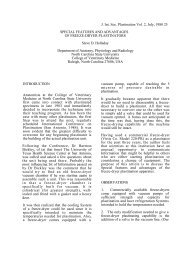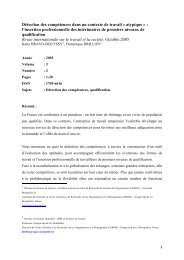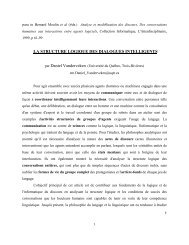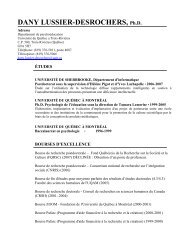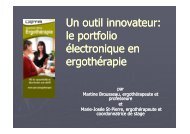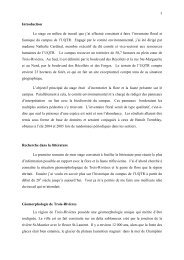Vascular patterns of plastinated human hands with special reference ...
Vascular patterns of plastinated human hands with special reference ...
Vascular patterns of plastinated human hands with special reference ...
You also want an ePaper? Increase the reach of your titles
YUMPU automatically turns print PDFs into web optimized ePapers that Google loves.
VASCULAR PATTERNS OF PLASTINATED<br />
HUMAN HANDS WITH SPECIAL REFERENCE<br />
TO ABNORMALITIES OF THE<br />
ARTERIAL PALMAR ARCHES<br />
INTRODUCTION<br />
G. Grondin and R Olry<br />
Universite du Quebec a Trois-Rivieres<br />
Departement de Chimie-Biologie<br />
CP500<br />
Trois-Rivieres, Quebec<br />
Canada G9A 5H7<br />
The vascular anatomy <strong>of</strong> the <strong>human</strong> hand is known to be<br />
<strong>of</strong> outstanding importance in medical, surgical and radiological<br />
sciences (Coleman and Anson, 1961; Kenesi et al., 1967; Braun<br />
et al., 1977), as well as in comparative anatomy and<br />
primatology (Manners-Smith, 1910; Sakka, 1972). The<br />
constitution, relationship and common abnormalities <strong>of</strong> both<br />
arterial palmar arches make their dissection difficult for<br />
students. The superficial palmar arch (Arcus palmaris<br />
superficialis) is <strong>of</strong>ten damaged during student dissection and<br />
subsequently much time is lost. Time is also lost trying to save<br />
the deep palmar arch (Arcus palmaris pr<strong>of</strong>undus). It was<br />
therefore decided to overcome this problem by producing<br />
<strong>plastinated</strong> specimens that would give the students a three<br />
dimensional view <strong>of</strong> the complete arteriovenous vascularization<br />
<strong>of</strong> the hand (Grodin and Olry, 1995). Initial trials <strong>of</strong><br />
injecting diluted silicone resin were not successful. Part <strong>of</strong><br />
the red resin, which had been injected first, was pushed from<br />
the arterial side via capillaries into the venous system. This<br />
led to the production <strong>of</strong> veins which were partly red, blue<br />
and purple. The next trials used pure silicone for the injection.<br />
One specimen was dissected to illustrate the superficial arterial<br />
palmar arch, a second one for the deep arterial palmar arch,<br />
and finally a third one for the venous drainage <strong>of</strong> the <strong>human</strong><br />
hand.<br />
SUBJECTS, MATERIALS AND METHODS<br />
Hands, free <strong>of</strong> any obvious traumatic or surgical history<br />
(absence <strong>of</strong> scars and wrist injuries), were removed from<br />
frozen subjects in the midforearm.<br />
Radial arteries from the frozen specimens were cannulated<br />
and water maintained at 25 cm <strong>of</strong> hydrostatic pressure was<br />
attached to the cannula. The cannulated specimens were held<br />
in cold running tap water for 12 hours while thawing. After<br />
thawing, ulnar arteries were also cannulated and any remaining<br />
blood was flushed from the vessels using a syringe filled <strong>with</strong><br />
water via radial and ulnar arteries. A mixture <strong>of</strong> Biodur S-10/<br />
S3/S6/S2, colored <strong>with</strong> red or blue Biodur Color Paste (AC50,<br />
AC52) was prepared to be injected into appropriate vessels.<br />
To prepare the injection mixture, a few drops <strong>of</strong> color paste<br />
were added to 30 ml <strong>of</strong> S-10/S3 mixture (100:1) and mixed<br />
until the color was uniform. After thorough mixing, 0.1 ml <strong>of</strong><br />
S6 and 0.1 ml <strong>of</strong> S2 were added to the S-10/S3 color-mix and<br />
stirred for 3 minutes. Arterial injection was carried out via<br />
the ulnar artery. When the silicone mixture started to ooze<br />
out via the radial artery, it was ligated and injection was<br />
continued until we noticed red silicone also oozing out from<br />
smaller arteries. Then the ulnar artery was also ligated. After<br />
arterial injection, venous injection (Specimen 3) was<br />
performed via one dorsal metacarpal veins. The proximal ends<br />
<strong>of</strong> the veins were left open for exit <strong>of</strong> water. When the silicone<br />
mixture started to ooze out via many veins, the forearm was<br />
mass ligated and injection was continued along <strong>with</strong> delicate<br />
massaging to allow filling <strong>of</strong> the distal veins.<br />
After vascular injection, <strong>hands</strong> were placed in cold<br />
modified Kaiserling's solution (Kaiserling, 1895) and stored<br />
in a cold room. Composition <strong>of</strong> the fixative solution was:<br />
potassium acetate (600 g), potassium nitrate (300g),<br />
formaldehyde 37% (400 ml), sugar (2000 g) and water<br />
(19.6L). Dissection was started in 24 hours and specimens<br />
were kept in the fixative solution for 3 to 5 weeks in the cold<br />
room.<br />
After dissection was completed, the specimens were rinsed<br />
in cold tap water for 12 hours, dehydrated in 4 successive<br />
baths <strong>of</strong> acetone at -20°C over a 4 week period, and defatted<br />
in room temperature in acetone for 5 days before being<br />
impregnated at -20°C <strong>with</strong> Biodur silicone S10, according to<br />
the standard technique (von Hagens, 1985; von Hagens et al.,<br />
1987).<br />
RESULTS<br />
The superficial palmar arch (Specimen 1) is supplied<br />
mainly by the ulnar artery. When the ulnar artery is the main<br />
supply to the palmar arch, it is referred to as "ulnar type"<br />
(Adachi, 1928). The superficial arch gives rise to three<br />
common palmar digital arteries (Aa. digitales palmares<br />
communes) and each <strong>of</strong> these divide into two proper palmar<br />
digital arteries (Aa. digitales palmares propriae) (Fig. 1).<br />
However, the radial participation to the superficial arch is in<br />
this case very particular: it shows what we believe to be a<br />
persistent antebrachial dorsal superficial artery (Arteria<br />
antebrachialis dorsalis superficialis) which does not traverse<br />
the first interosseous space (Georgeiwski, 1905). The relationship<br />
<strong>of</strong> the radial artery and its embryological remnant seem<br />
to resemble the type VI described by Adachi (1928) who<br />
assigned a frequency <strong>of</strong> 1.5% to this kind <strong>of</strong> anomaly (Fig. 2).<br />
The deep palmar arch (Specimen 2), which is known to<br />
be less variable than the superficial one (Braun et al., 1977),<br />
also showed an anomaly. Its medial origin arises from the<br />
palmar digital artery <strong>of</strong> the little finger (Fig. 3) and not from<br />
the ulnar artery, an anomaly which was not described by Adachi<br />
(1928).<br />
The superficial venous drainage <strong>of</strong> the hand (Specimen<br />
3) show's a classical plexiform morphology <strong>with</strong> some dorsal<br />
metacarpal veins and their anastomotic network (Fig. 4). It is<br />
noteworthy that the color mixture was stopped here and there<br />
by venous valves which even occur in the small veins (Fig. 5).<br />
Deep veins were also colored via the numerous interconnections<br />
between the superficial and deep venous<br />
networks (Fig. 6).<br />
19
DISCUSSION<br />
The aim <strong>of</strong> this study was to provide <strong>plastinated</strong> <strong>human</strong><br />
hand specimens which would help students to understand<br />
the vascular anatomy <strong>of</strong> the hand. The complexity <strong>of</strong> this<br />
region, as well as its numerous vascular variations (Adachi,<br />
1928; Coleman and Anson, 1961; Kenesi et al., 1967),<br />
dishearten most students who try to dissect the complex<br />
venous and arterial <strong>patterns</strong> <strong>of</strong> the hand. Plastinated specimens<br />
are therefore appreciated as students can regularly refer to<br />
models during their anatomical curriculum (Olry and Grondin,<br />
1994; C6te et al, 1995).<br />
We have shown that an appropriate arterial injection is<br />
capable <strong>of</strong> filling and thus coloring the whole arterial network,<br />
including very small size subcutaneous vessels (Fig. 6). The<br />
size <strong>of</strong> the smallest colored arterioles were accurately<br />
measured using an optical comparator (Mitutoyo). Their size<br />
was 0. 1mm. This could provide an opportunity for the analysis<br />
<strong>of</strong> very thin vascular networks in the future.<br />
A complete rinsing <strong>of</strong> the venous system is very important.<br />
A sole injection in a dorsal metacarpal vein allowed the filling<br />
<strong>of</strong> both superficial and deep venous networks provided that<br />
the veins were compressed several times when we noticed a<br />
venous valve stopping the color mixture. The presence <strong>of</strong><br />
numerous valves explains that some veins were filled against<br />
the current and that water remained trapped in some veins<br />
. 5).<br />
ACKNOWLEDGMENTS<br />
The authors wish to thank M. Claude Demers for his help<br />
in photography.<br />
REFERENCES<br />
Adachi B, Das Arteriensystem der Japaner. Kyoto: Verlag der<br />
Kaiserlich-Japanischen Universitat zu Kyoto, 1928.<br />
Braun, J.B., Werner, J.E., Borrelly, J.: Etude radio-anatomique<br />
des arteres de la main. Bull Soc Anat 174:317-329,1977.<br />
Coleman, S.S., Anson, B J.: Arterial <strong>patterns</strong> in the hand based<br />
upon a study <strong>of</strong> 650 specimens. Surg Gyn Obst 113:<br />
409-424,1961.<br />
Georgiewski, J.V.: Zur Kasuistik des hohen Ursprungs und der<br />
subcutanen Lage des Ramus dorsalis der Arteria radialis.<br />
Schwalbe'sjahresber 11:315,1905.<br />
Grondin G., Olry, R.: <strong>Vascular</strong>ization <strong>of</strong> the <strong>human</strong> hand<br />
demonstrated <strong>with</strong> S-10 <strong>plastinated</strong> specimens. 4th<br />
Interim Conference on Plastination, Columbus, Ohio, July<br />
1995.<br />
Kaiserling, C: Uber die Konservierung von Sammlungspräparaten<br />
mit Erhaltung der naturlichen Farben. Fortschr Anat<br />
EntwGesch 2:221,1895.<br />
Kenesi, C., Alexandre, J.H., Aaron, C.: Les arteres de la main.<br />
Arch Anat Path 15:99-102,1967.<br />
Manners-Smith MA: The limb arteries <strong>of</strong> primates. J Anat<br />
44:271-302,1910.<br />
Olry R., Grondin, G.: Plastination in chiropractical teaching:<br />
critical analysis and place <strong>of</strong> <strong>plastinated</strong> specimens in<br />
anatomical pedagogics. 7th International Conference on<br />
Plastination, Graz, Austria, July 1994.<br />
Sakka M.: Arteres de la main chez les primates superieurs. C R<br />
Ass Anat 155:1350-1358, 1972.<br />
von Hagens, G.: Heidelberg Plastination Folder-. Collection <strong>of</strong><br />
all technical leaflets for plastination. Anatomisches Institut<br />
1, Universitat Heidelberg, 1985.<br />
von Hagens, G., Tiedemann, K., Kriz, W: The current potential<br />
<strong>of</strong> plastination. Anat Embryol 175:411-421,1987.<br />
SUMMARY<br />
Specimens were dissected and <strong>plastinated</strong> in order to<br />
demonstrate the arterial and venous vascularization <strong>of</strong> <strong>human</strong><br />
<strong>hands</strong>. Vessels were injected <strong>with</strong> appropriate colors and<br />
plastination was performed according to the standard S-10<br />
technique. We showed that 1) a sole injection via ulnar artery<br />
is capable <strong>of</strong> filling very small size arterioles and 2) injection<br />
via only one dorsal metacarpal vein allows to completely fill<br />
the superficial and deep venous systems, provided that veins<br />
are carefully massaged during the injection to open the valves.<br />
Cote, M.E., Christin, M.J., Fortin, M.J., Olry, R.: Plastination: a<br />
new approach to the teaching <strong>of</strong> topographical anatomy.<br />
Chiropractic Centennial Foundation, Washington, D.C.,<br />
July 1995.<br />
20
Figure 1. Palmar aspect <strong>of</strong> the superficial palmar arch. Ulnar<br />
artery (arrow), common palmar digital arteries (arrowheads).<br />
Figure 4. Dorsal venous network <strong>of</strong> the hand. Artifact due to<br />
the breakage <strong>of</strong> venous wall at the site <strong>of</strong> injection (arrow).<br />
Figure 2. Radial aspect <strong>of</strong> the radial participation to the<br />
superficial palmar arch. Radial artery (arrow), putative<br />
antebrachial dorsal superficial artery (arrowheads).<br />
Figure 5. Close-up <strong>of</strong> the dorsal metacarpal veins. Location<br />
<strong>of</strong> small venous valves (arrowheads), remaining water trapped<br />
upstream <strong>of</strong> a venous valve (arrow).<br />
Figure3. Palmar aspect <strong>of</strong> the deep palmar arch. Deep palmar arch<br />
(white arrow), digital artery <strong>of</strong> the little finger (black arrows).<br />
Figure 6. Close-up <strong>of</strong> the radial aspect <strong>of</strong> the wrist region.<br />
Radial artery (star) flanked by both radial veins, subcutaneous<br />
arteriole (arrow).<br />
21



